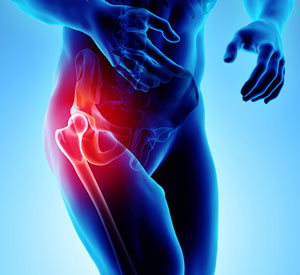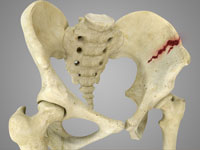- Hip Pain

Hip pain, one of the common complaints, may not always be felt precisely over the hip joint rather in and around the hip joint. The cause for pain is multifactorial and the exact position of your hip pain suggests the probable cause or underlying condition causing it.
Know More
Hip Arthritis
- Osteoarthritis of the Hip

Osteoarthritis, also called degenerative joint disease, is the most common form of arthritis. It occurs most often in the elderly. This disease affects the tissue covering the ends of bones in a joint called cartilage.
Know More - Inflammatory Arthritis of the Hip

The inflammation of the joints is referred to as arthritis. Inflammation arises when the smooth lining called cartilage at the ends of bones wears away. In some cases, the inflammation is caused when the lining of the joint becomes inflamed as part of an underlying systemic disease. These conditions are referred to as inflammatory arthritis.
Know More
Hip Injury
- Hip Ligament Injuries

Injuries to the hip ligaments are commonly called a hip sprain and can range from minor tears of the ligaments to more serious injuries involving the hip muscles, tendons or bone.
Know More - Hip Adductor Injuries

A hip adductor injury is also called a groin strain or groin tear and involves any of the adductor muscles. These injuries are common among athletes and those who play hockey, football, soccer, basketball, tennis, baseball, etc.
Know More - Hamstring Injuries

The hamstring is a group of three muscles that run along the back of the thigh from the hip to the knee. Hamstring injuries occur when these muscles are strained or pulled. They are common in dancers and athletes of all sorts including runners and those who play football, soccer, basketball, tennis, etc.
Know More - Gluteus Tendon Tear

The gluteal muscles (situated in the buttocks) are necessary for the stability and movement of the hip joints. The tendons of two gluteal muscles (gluteus medius and gluteal minimus) are attached at the outer hip region and are often called the “rotator cuff of the hip.”
Know More - Hip Labral Tear

A hip labral tear is an injury to the labrum, the cartilage that surrounds the outside rim of your hip joint socket.
Know More - Gluteus Medius Tear

A gluteus medius tear is the partial or complete rupture of the gluteus medius muscle due to severe muscle strain. Gluteus medius tears often occur at the tendinous attachment to the greater trochanter of the femur bone.
Know More Launch Movie
Hip Fracture
- Stress Fractures of the Hip

Stress fractures of the hip are a break in the upper part of the thigh bone (femur) that fits into the socket of the hip joint. It can occur in any part of the hip, however, it mostly occurs just below the ball of the ball-and-socket hip joint called the femoral neck.
Know More - Avulsion Fractures of the Pelvis

Avulsion fractures of the pelvis is an injury that occurs when a tendon or ligament pulls off a piece of bone from the hip. This results in a part of the pelvic (hip) bone breaking away from the main part of the bone.
Know More - Periprosthetic Hip Fractures

Hip replacement is a surgical procedure in which the damaged cartilage and bone are removed from the hip joint and replaced with artificial components. Any resulting fractures or breaks in the bone around the implant are called periprosthetic hip fractures. They usually occur around the stem of the implant and sometimes to the socket (acetabulum).
Know More - Femoral Neck Fracture

The hip is a ball-and-socket joint made up of the head of the thigh bone or femur that acts as the ball and fits into the rounded socket of the hip bone or acetabulum. The neck of the femur is the region just below the ball of the hip joint.
Know More Launch Movie - Subtrochanteric Hip Fracture

A hip fracture is a break that occurs near the hip in the upper part of the femur or thighbone. The thighbone has two bony processes on the upper part - the greater and lesser trochanters.
Know More Launch Movie - Femoral Shaft Fracture

A femoral shaft fracture is a crack or break anywhere along the long and straight section of the femur (thighbone) due to high-energy trauma or low-energy trauma in osteoporotic patients. The femur is the strongest and longest bone in the body. It connects with the pelvis at the top to form the hip joint and the tibia and fibula at the bottom to form the knee joint.
Know More - Pelvic Fractures

A pelvic fracture is a condition that occurs due to the breakage of the pelvic bone. It may cause damage to the internal organs, nerves and blood vessels associated with the pelvic region.
Know More - Acetabular Fracture

An acetabular fracture is a break in the acetabulum (ball-and-socket portion) of the hip joint. It usually occurs during high-energy injuries.
Know More
Intertrochanteric Fractures
- Femur Fracture

The femur or thigh bone is the longest and strongest bone in the body, connecting the hip to the knee. A femur fracture is a break in the femur. The distal femur is the lower part of the thigh bone which flares out like an upside-down funnel and its lower end is covered by a smooth, slippery articular cartilage that protects and cushions the bone during movement.
Know More
- Hip Instability

Injury or damage to these structures can lead to a condition called hip instability when the joint becomes unstable.
Know More - Gluteal Strain

A gluteal strain is a condition characterized by a partial or complete tear of the gluteus muscles, also known as the buttocks. The gluteus muscles are a group of strong muscles present at the back of the pelvis. These muscles help with the movement and stabilization of the hip joint.
Know More - Hip Flexor Strain

A hip flexor strain is an overuse injury to the flexor muscles of your hip and can range from a minor stretch injury to a complete tear of the muscle fibers or tendons.
Know More - Labral Cysts of the Hip

Labral cysts are small and well-defined fluid-filled sacs or lesions found adjacent to the cartilage labrum, a rim of tissue that surrounds the acetabulum (hip socket) and seals the hip joint.
Know More - Iliopsoas Tendonitis

Iliopsoas tendonitis also referred to as snapping hip syndrome, is an inflammation of the iliopsoas tendon or the surrounding area. The iliopsoas is the hip flexor tendon located over the front of the hip socket. The term snapping hip describes the sound made, a snap or click, that occurs with certain hip movements including flexion, extension, and rotation of the hip.
Know More Launch Movie - Iliopsoas Impingement

Iliopsoas impingement also known as internal snapping hip syndrome is a condition characterized by inflammation and pain in the iliopsoas muscles resulting in abnormal movement of the hip.
Know More - Femoroacetabular Impingement

Femoroacetabular impingement (FAI) is a condition characterized by excessive friction in the hip joint from the presence of bony irregularities. These cause pain and decreased range of hip motion.
Know More Launch Movie - Hip Bursitis

Hip bursitis is a painful condition caused by the inflammation of a bursa in the hip. Bursae are fluid-filled sacs present in the joints between bone and soft tissue to reduce friction and provide cushioning during movement.
Know More Launch Movie - Avascular Necrosis

Avascular necrosis, also called osteonecrosis, is a condition in which bone death occurs because of inadequate blood supply to it. Lack of blood flow may occur when there is a fracture in the bone or a joint dislocation that may damage nearby blood vessels. Hip joint is most commonly affected; however, the knee and shoulder may also be involved.
Know More - Hip Dislocation

The hip joint is a “ball and socket” joint. The “ball” is the head of the femur or thighbone, and the “socket” is the cup-shaped acetabulum. The joint is surrounded by muscles, ligaments, and tendons that support and hold the bones of the joint in place.
Know More - Hip Abductor Tears

Hip abductors are a major group of muscles found in the buttocks. It includes the gluteus maximus, gluteus medius, gluteus minimus, and tensor fascia lata muscles.
Know More - Developmental Dysplasia

Developmental dysplasia of the hip (DDH) or hip dysplasia is a condition that is seen in infants and young children because of developmental problems in the hip joint. The femur (thighbone) partially or completely slips out of the hip socket leading to dislocation at the hip joint. It is most common in the first-born baby with a family history of the disorder.
Know More - Irritable Hip

Irritable hip, also known as acute transient synovitis, is a common disorder of childhood characterized by hip pain and limping. The term transient means that it does not last long. It usually occurs before puberty and affects only one hip. Boys aged between 4 to 10 years are most often affected.
Know More - Transient Osteoporosis of the Hip

Transient osteoporosis of the hip is a rare condition that causes temporary bone loss in the upper region of the thighbone (femur). It occurs most often in young or middle-aged men of the age groups 30 to 60, and women in their later stages of pregnancy or early postpartum (following childbirth). It is characterized by abrupt onset of pain that increases with activity.
Know More
































